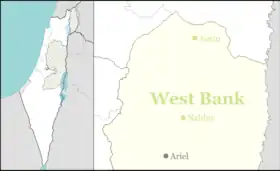Alfei Menashe
| |
|---|---|
Local council (from 1987) | |
| Hebrew transcription(s) | |
| • ISO 259 | ʔalpei Mnašše |
| • Also spelled | Alfe Menashe (official) |
 | |
 Alfei Menashe | |
| Coordinates: 32°10′20″N 35°0′53″E / 32.17222°N 35.01472°E | |
| Region | West Bank |
| District | Judea and Samaria Area |
| Founded | 1983 |
| Government | |
| • Head of Municipality | Shy Rosenzweig |
| Area | |
| • Total | 4,616 dunams (4.616 km2 or 1.782 sq mi) |
| Population (2021)[1] | |
| • Total | 7,966 |
| • Density | 1,700/km2 (4,500/sq mi) |
| Name meaning | Thousands of the tribe of Manasseh |
Alfei Menashe (Hebrew: אַלְפֵי מְנַשֶׁה, Arabic: ألفي منشيه, , lit. Thousands of Manasseh) is an Israeli settlement on the western edge of the central West Bank. Built over land confiscated from the nearby Palestinian villages of Nabi Ilyas,[2] Islah,[3] and Ras Atiya,[4] it is located in the so-called seam zone of the West Bank.[5] Its name is taken from the bible (Deuteronomy 33:17). It was granted local council status in 1987. In 2021 its population was 7,966.
The international community considers Israeli settlements in the West Bank illegal under international law, but the Israeli government disputes this.[6]
History
According to ARIJ, Israel confiscated land from several Palestinian villages in order to construct Alfei Menashe:
- 1,943 dunums of land (43.8% of the total village lands) was taken from Nabi Ilyas,[2]
- 651 dunums of land were taken from ‘Arab Abu Farda,[7]
- 131 dunums of land were taken from Islah,[3]
- 51 dunes were taken from Ras Atiya.[4]
The town's proximity to the Green Line (less than 2 kilometres (1.2 mi) east) and its similar proximity to the Palestinian Arab town of Qalqilyah has made its inclusion on the Israeli side of the West Bank barrier controversial, especially as the looping nature of the barrier's path forms a quasi-enclave of some Palestinian villages to its south. In September 2005, Israel's Supreme Court ruled that the government must consider re-routing the barrier in this area. Work was begun in the summer of 2009 to construct a new route for the barrier, which will no longer incorporate the Palestinian village of Ras al-Tira (and several other villages) on the Israeli side. The work was finished in 2011. (source: Google Earth)
The settlement is the hometown of Israel's most successful mixed martial artist Noad Lahat.

References
- ↑ "Regional Statistics". Israel Central Bureau of Statistics. Retrieved 22 February 2023.
- 1 2 An Nabi Elyas Village Profile, p. 17
- 1 2 ‘Azzun Town Profile (including ‘Isla & ‘Izbat at Tabib Localities), ARIJ, p. 23
- 1 2 Ras ‘Atiya Village Profile (including Ras at Tira & Wadi ar Rasha Localities), ARIJ, p. 18
- ↑ "More Housing Units: New Tenders in Israeli West Bank Settlements". ARIJ (Applied Research Institute - Jerusalem. 2006-10-04. Archived from the original on 2011-05-19. Retrieved 2007-07-13.
- ↑ "The Geneva Convention". BBC News. 10 December 2009. Retrieved 27 September 2011.
- ↑ Arab Abu Farda Village Profile, ARIJ, p. 14
External links
- Official website (in Hebrew)